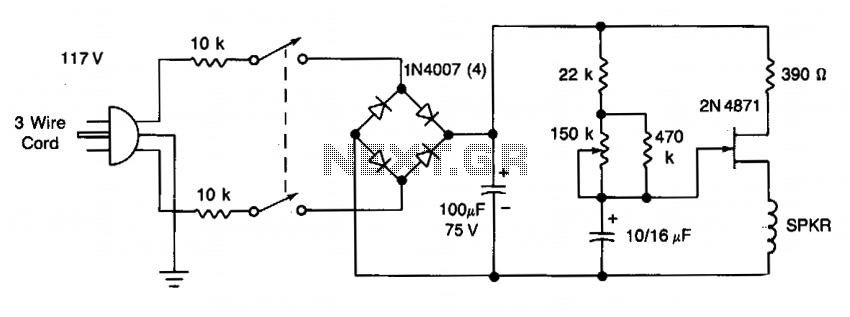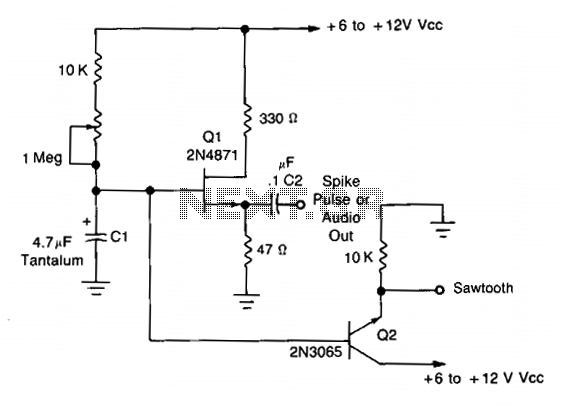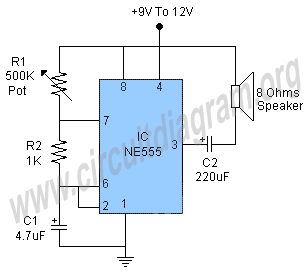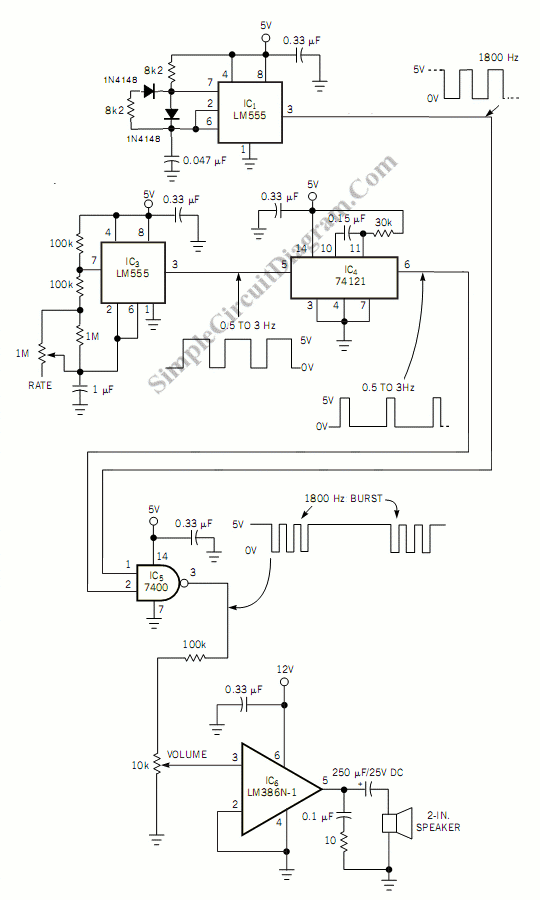
Unijunction metronome

The frequency of the UJT oscillator is determined by the 100 µF capacitor and the effective resistance of the 22 Ω and 470 Ω resistors, along with a potentiometer. The rate can be varied from 42 to 208 beats per minute. Additionally, the circuit should be housed in an insulated box for safety or utilize a grounded (3-wire) cord.
The UJT (Unijunction Transistor) oscillator circuit operates by utilizing the unique characteristics of the UJT to generate a repetitive waveform. The frequency of oscillation is primarily influenced by the timing capacitor (100 µF) and the resistive components, which include a fixed 22 Ω resistor, a fixed 470 Ω resistor, and an adjustable potentiometer. The combination of these resistive elements creates a voltage divider that controls the charging and discharging cycle of the capacitor, thus determining the oscillation frequency.
The UJT oscillator can achieve a frequency range from 42 to 208 beats per minute, making it suitable for various applications such as timing circuits, tone generation, or as a pulse generator in other electronic systems. The UJT's ability to switch on and off rapidly allows for precise control over the output waveform, which can be a square wave or sawtooth depending on the configuration of the circuit.
For safety considerations, it is essential to house the entire circuit within an insulated enclosure. This not only protects the components from environmental factors but also minimizes the risk of electrical shock. Alternatively, using a grounded three-wire cord ensures that any fault currents are safely directed to the ground, providing an additional layer of safety for the user.
Overall, the UJT oscillator circuit is a versatile and effective solution for generating variable frequency signals, with important design considerations for safety and reliability.The UJT-oscillator frequency is determined by the 100 µ¥ capacitor and the effective resistance of the 22 and 470 resistors and the potentiometer. Rate can be varied from 42 to 208 beats/minute. The circuit should be housed in an insulated box for safety, or use ground (3-wire cord).
The UJT (Unijunction Transistor) oscillator circuit operates by utilizing the unique characteristics of the UJT to generate a repetitive waveform. The frequency of oscillation is primarily influenced by the timing capacitor (100 µF) and the resistive components, which include a fixed 22 Ω resistor, a fixed 470 Ω resistor, and an adjustable potentiometer. The combination of these resistive elements creates a voltage divider that controls the charging and discharging cycle of the capacitor, thus determining the oscillation frequency.
The UJT oscillator can achieve a frequency range from 42 to 208 beats per minute, making it suitable for various applications such as timing circuits, tone generation, or as a pulse generator in other electronic systems. The UJT's ability to switch on and off rapidly allows for precise control over the output waveform, which can be a square wave or sawtooth depending on the configuration of the circuit.
For safety considerations, it is essential to house the entire circuit within an insulated enclosure. This not only protects the components from environmental factors but also minimizes the risk of electrical shock. Alternatively, using a grounded three-wire cord ensures that any fault currents are safely directed to the ground, providing an additional layer of safety for the user.
Overall, the UJT oscillator circuit is a versatile and effective solution for generating variable frequency signals, with important design considerations for safety and reliability.The UJT-oscillator frequency is determined by the 100 µ¥ capacitor and the effective resistance of the 22 and 470 resistors and the potentiometer. Rate can be varied from 42 to 208 beats/minute. The circuit should be housed in an insulated box for safety, or use ground (3-wire cord).





